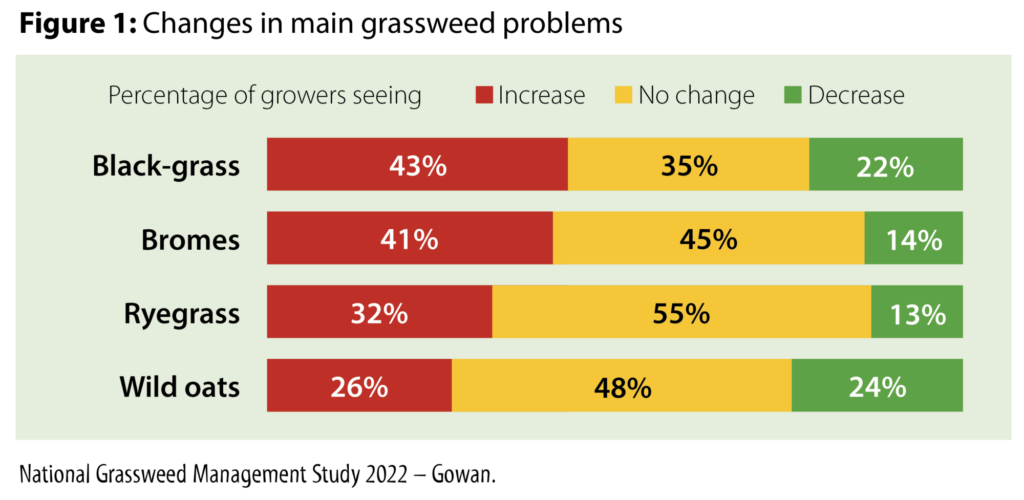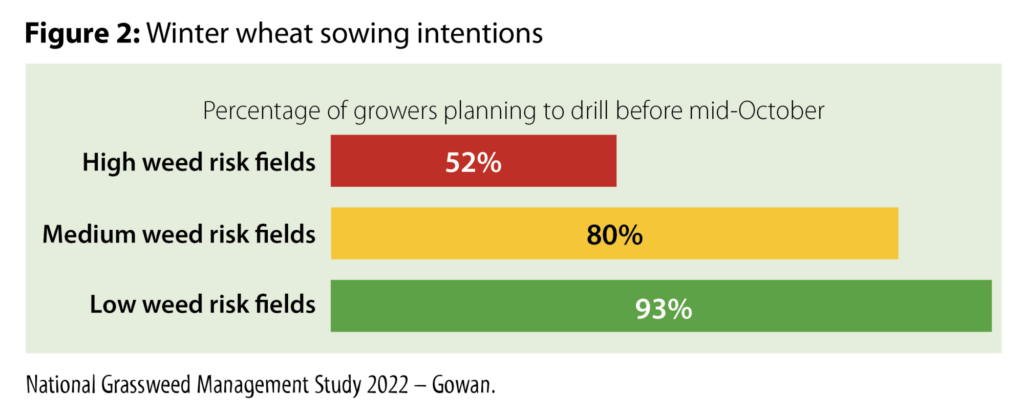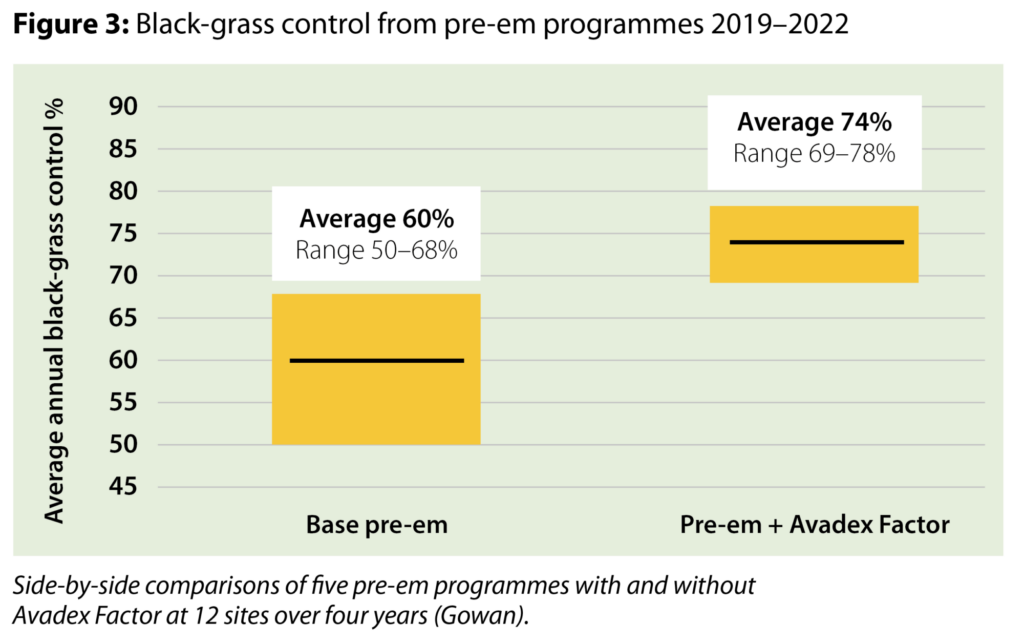Earlier wheat drilling puts particular pressure on pre-ems this autumn
10th October 2022
Despite growing grassweed problems across the country, many growers are keen to minimise their wheat establishment risks by drilling earlier than advisable for the best cultural control, reveals the latest in a series of national studies. This will put particular pressure on pre-em herbicides, making the most robust and resilient programmes more essential than ever.
Conducted by Gowan Crop Protection this summer, with more than 260 growers up and down the UK managing a total of just under 90,000ha of cropping, the 2022 National Grassweed Management Study spans a broad range of enterprises, establishment regimes and weed management practices.
It shows black-grass, ryegrass, brome and wild oat infestations continue to be widespread, with three quarters or more of growers having at least some problem with each, and more growers reporting an increase than a decrease in problems in each case (Figure 1).

National Grassweed Management Study 2022 – Gowan.
“Interestingly, the proportion seeing increasing black-grass problems is lower than it was in a similarly comprehensive national survey conducted by Bayer in 2016,” points out study co-ordinator, Hank King (pictured) of Gowan.
“This clearly suggests the integrated approaches growers have been taking to deal with black-grass in recent years are having the desired effect.
“Unfortunately, the same cannot be said for bromes, ryegrass and wild oats, though. In all three cases, the proportion of growers seeing increasing problems with these weeds over the past four seasons is going up and the proportion reporting decreases going down. The situation is particularly worrying with ryegrass and wild oats.
“Equally concerning is the fact that problems with mixed grassweeds rather than just single species are reported by half of growers; especially so since control measures that work well with one species may not be the most appropriate for others.”
The 2022 study shows black-grass remaining the most significant grassweed issue for most growers, with nearly a quarter reporting problems across half or more of their winter cereals area and over a half across more than 10%. Wild oats are the second most problematic grassweed, with bromes and ryegrass somewhat less significant in their scale.
Black-grass with wild oats, and black-grass with bromes are the most widely encountered grassweed combinations, with wild oats proving a challenge in combination with other species for more than 50% of growers.
“Black-grass continues to be much more problematic in the south and east of the country than in the west and north,” Mr King notes. “If anything, though, the weed now appears to be more of an issue in the southern counties than in the historically worst-affected eastern regions. And it remains most concerning under reduced tillage regimes.
“As well as in reduced tillage systems, bromes are especially problematic in both the southern and northern counties. While there are clear hotspots elsewhere, ryegrass problems are most widespread in the south and among those with shallow min till regimes. Wild oat problems, however, are more evenly distributed across the country and, like the other grassweeds, noticeably less under plough-based winter cereal establishment regimes.
“Herbicide resistant black-grass is continuing to cause issues for most growers, reveals the study, with over half reporting serious or very serious problems from resistance,” he adds. “Almost a quarter of growers are seeing similarly concerning resistance problems in ryegrass, with 16% finding issues that may be resistance-related in bromes.”
Cultural control
Of the 12 main cultural grassweed control techniques, the study reveals growers are currently employing an average of 9.7 in their management – an encouraging increase on the average of 6.3 of the same techniques identified in the 2016 survey.
The five most widely used cultural grassweed controls – each employed by 85% or more of growers – continue to be spring cropping, stale seedbeds, delayed autumn drilling, rotational ploughing and increased seed rates. In all cases these are being more widely used than four years ago and are scored relatively highly for their effectiveness by growers.
“With grassweed problems continuing to increase, it is worrying to see relatively large numbers of growers planning to drill their wheat earlier than advisable this season,” Mr King observes.
“Heeding the best advice, many growers are still setting mid-October as their target start date for wheat drilling on high grassweed risk fields to give time to spray-off the largest flushes of weed growth ahead of sowing. However, 52% are now looking to drill high risk fields and 80% medium-risk fields before this time – presumably to minimise their establishment risk from the weather (Figure 2).

National Grassweed Management Study 2022 – Gowan.
“This puts even more pressure on pre-em herbicides, making correct choice and use more critical than ever; not least given the dependence of most chemistry on both weather and seedbed quality for its performance.”
Pre-em performance
Regardless of claimed efficacy, soil-acting herbicide activity fundamentally depends on the season – primarily the weather. If conditions are too dry there isn’t enough moisture for most of today’s chemistry to work. Equally, if they’re too wet the herbicidal layer in the soil on which their activity depends is disrupted.
Extensive Gowan trials, for instance, show five typical pre-em programmes – including the newest chemistry – giving an average black-grass control of 60% across 12 sites over the past four seasons, and varying from 50% to 68% between seasons.
Encouragingly, the addition of liquid tri-allate (Avadex Factor) to these programmes boosted average control to 74% while halving the season-to-season variation (Figure 3).

Side-by-side comparisons of five pre-em programmes with and without Avadex Factor at 12 sites over four years (Gowan).
“Working as vapour in the air spaces within the soil rather than in the moisture ensures Avadex maintains as much effectiveness as possible in drier seedbeds,” explains Mr King. “Its very low water solubility also means excessive rainfall has far less effect on it than other chemistry.
“Added to this, tri-allate acts on multiple enzyme systems within the young plant to inhibit the synthesis of long chain fatty acids – including waxes. This means that weed seedlings not killed directly by the herbicide tend to emerge with substantially less leaf wax to interfere with the uptake of other chemistry.
“Growers and agronomists have long appreciated the extra black-grass, brome and ryegrass control value Avadex gives their pre-em programmes,” he concludes. “And it’s interesting to see this being maintained with the newest chemistry on the market.
“The season-proofing Avadex Factor so clearly provides to pre-em programmes will be particularly valuable for those drilling wheat earlier than advisable this autumn.
“It will be most important under the reduced tillage regimes our study shows invariably have the greatest challenges from grassweeds. Also, where mixed grassweed populations, in general, and wild oat infestations, in particular, are problematic; not least because employing it in the autumn pre-em spray can frequently eliminate the need for subsequent wild oat spraying in the spring.”

